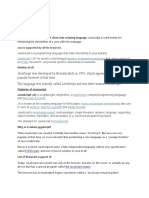Chapter 1 Introduction to JavaScript
Uploaded by
sumit1111666Chapter 1 Introduction to JavaScript
Uploaded by
sumit1111666Chapter 1: Introduction to JavaScript
Importance:
JavaScript is a versatile and essential programming language used primarily for client-side web
development. It allows developers to create dynamic and interactive websites, making it an integral
part of modern web development alongside HTML and CSS.
Usage:
- Adding interactivity to web pages (buttons, sliders, forms)
- Creating browser-based games and applications
- Validating user inputs
- Interacting with APIs and handling asynchronous data
- Building front-end frameworks (React, Angular, Vue)
Topics Covered:
1. What is JavaScript?
2. History and Evolution
3. JavaScript vs. Other Languages
4. JavaScript in the Browser
5. Setting Up Your Environment
6. Writing Your First Script
7. Console, Alert, Prompt, and Confirm
8. Comments and Code Readability
1. What is JavaScript?
JavaScript is a scripting language used to create and control dynamic website content such as
animated graphics, interactive forms, slideshows, and more.
2. History and Evolution:
- Created by Brendan Eich in 1995
- Initially named Mocha, then LiveScript, and finally JavaScript
- Standardized as ECMAScript (ES)
3. JavaScript vs. Other Languages:
- Interpreted language (no need for compilation)
- Works in all modern web browsers
- Can be used for both frontend and backend (Node.js)
4. JavaScript in the Browser:
JavaScript is embedded directly into HTML documents and is executed by the browser. It can
manipulate HTML and CSS through the DOM.
5. Setting Up Your Environment:
You only need a web browser and a code editor (e.g., VS Code). Open a `.html` file and write
JavaScript within <script> tags.
6. Writing Your First Script:
Example:
<script>
alert('Hello, JavaScript!');
</script>
Output:
A popup appears saying "Hello, JavaScript!"
7. Console, Alert, Prompt, and Confirm:
- console.log() - Prints messages to the browser console
- alert() - Displays alert popups
- prompt() - Gets user input
- confirm() - Shows a yes/no dialog box
8. Comments and Code Readability:
- Single-line comment: // This is a comment
- Multi-line comment: /* This is a block comment */
Tip:
Always comment complex logic and use indentation for better readability.
Conclusion:
JavaScript is the heart of modern interactive websites. Understanding its basics is crucial for
building engaging web applications.
You might also like
- Javascript - Info Full Tutorial Ebook PDF92% (12)Javascript - Info Full Tutorial Ebook PDF1,320 pages
- Javascript For Beginners: Your Guide For Learning Javascript Programming in 24 HoursFrom EverandJavascript For Beginners: Your Guide For Learning Javascript Programming in 24 Hours3/5 (13)
- Sage A. JavaScript Programming. From Beginners To Expert in 45 Days,... 2024No ratings yetSage A. JavaScript Programming. From Beginners To Expert in 45 Days,... 202469 pages
- JavaScript Mastery_ From Basics to Advanced TechniquesNo ratings yetJavaScript Mastery_ From Basics to Advanced Techniques146 pages
- Buliding Interactive Web-pages With JavascriptNo ratings yetBuliding Interactive Web-pages With Javascript109 pages
- Demystifying JavaScript Your Guide To Web Development's Essential LanguageNo ratings yetDemystifying JavaScript Your Guide To Web Development's Essential Language5 pages
- Introduction To Javascript: Pat Morin Comp2405No ratings yetIntroduction To Javascript: Pat Morin Comp240534 pages
- (Ebook) Javascript.info Ebook Part 1 The JavaScript language by Ilya Kantor, javascript.info download pdf100% (11)(Ebook) Javascript.info Ebook Part 1 The JavaScript language by Ilya Kantor, javascript.info download pdf55 pages
- Essential Javascript™ For Web Professionals0% (2)Essential Javascript™ For Web Professionals162 pages
- Beginning Modern Javascript a Step by Step Gentle Guide to LearnNo ratings yetBeginning Modern Javascript a Step by Step Gentle Guide to Learn186 pages
- 155622852X {831B60CA} Advanced Javascript (2nd Ed.) [Easttom 2001-05-25]No ratings yet155622852X {831B60CA} Advanced Javascript (2nd Ed.) [Easttom 2001-05-25]733 pages
- JavaScript Programming - A Step-by-Step Guide For Absolute BeginnersNo ratings yetJavaScript Programming - A Step-by-Step Guide For Absolute Beginners149 pages
- Javascript info Ebook Part 1 The JavaScript language 1st Edition Ilya Kantor pdf download100% (5)Javascript info Ebook Part 1 The JavaScript language 1st Edition Ilya Kantor pdf download60 pages
- JavaScript Programming - A Step-by-Step Guide For Absolute BeginnersNo ratings yetJavaScript Programming - A Step-by-Step Guide For Absolute Beginners243 pages
- How Javascript Works Master The Basics Of Javascript And Modern Web App Development 1st Edition Jonathon Simpson pdf downloadNo ratings yetHow Javascript Works Master The Basics Of Javascript And Modern Web App Development 1st Edition Jonathon Simpson pdf download85 pages
- Javascript info Ebook Part 1 The JavaScript language 1st Edition Ilya Kantor - The ebook in PDF format with all chapters is ready for download100% (1)Javascript info Ebook Part 1 The JavaScript language 1st Edition Ilya Kantor - The ebook in PDF format with all chapters is ready for download61 pages



























































